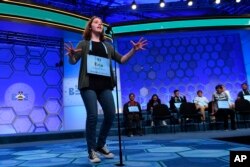The spelling and vocabulary contest known as the National Spelling Bee in the United States was inaugurated in 1925 with help of nine American newspapers.
While the winning elementary and middle school students had family names of Neuhauser, Bell, Lucas, Robinson, Hogan, Jensen and Randall in the contest's first years, beginning in the 1980s, children from South Asian immigrant families, particularly India, have started gaining a solid footing among champions.
In fact, from 2008 until 2018, winners of every single year's spelling bee hail from families of Indian heritage.
This year, the southern state Alabama's 14-year-old Erin Howard was the lone non-Indian American who won the prestigious championship along with seven other kids, aged 12 and 13, all of whom came from Indian American families.
While some have expressed concern that the contest appears to be dominated by Indian Americans, the competition's organizers don't seem to be troubled.
"We are proud of the diversity of our participants and are delighted with the success of Indian-American students in our program," Paige P. Kimble, executive director of the Scripps National Spelling Bee, tells VOA.
Writing for the Los Angeles Times, Shalini Shankar, professor of anthropology and Asian American studies at Northwestern University, herself a native of Mumbai, India, points out that "spelling bees have become a vital part of the Indian American experience."
Shankar credits "a confluence of factors" that include "feel-good documentaries that inspired future spellers, a culture invested in competitive spelling and parental investment in a child's educational success" to the persisting phenomenon of Indian-American students' domination of the national spelling bee contests in the last decade.
According to the Spelling Bee's official website, 11 million students across America, from grades one to eight (aged seven to 15), participated in spelling bee contests this year, a majority (65%) of them enrolled in public schools. The southern state of Texas so far boasts the most champions.
In addition to students who already live and study in the United States, Kimble says this year's competition also had participants from Canada, Jamaica, Germany, The Bahamas, Ghana, Japan and South Korea.
Kimble tweeted that "the school bee winner is often the one who memorized a 450-word list. The regional winner is the one who memorized a 1500-word list; has broad knowledge of roots and patterns; and composure in applying knowledge to off-list words asked at the end of the bee."
The Merriam-Webster unabridged online dictionary, "a dictionary of American English," as Kimble puts it, serves as the official source where contest words are found.
Following its news report of the 2019 national competition that saw eight parallel winners, each bringing home a $50,000 cash prize (which they all reportedly indicated an interest in putting aside for their college education), The New York Times gave readers an opportunity to try out the paper's own Spelling Bee contest, a step-up from the usual Crossword feature.
Kimble, the executive director of the Scripps National Spelling Bee, a non-profit organization under The E. W. Scripps Company, a Cincinnati, Ohio-based media conglomerate, says there is also a yearly Bee in the nation's capital between members of the press and members of congress. Winner of the 2018 contest was a journalist writing for The Washington Post. In 1913, when the first such Bee took place, Congressman Frank B. Willis from Ohio [who went on to become the state's governor] beat participating scribes in that "most American of showdowns."












